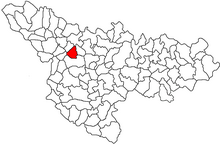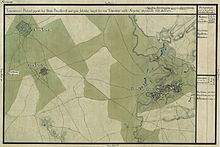Becicherecu Mic
|
Becicherecu Mic Klein-Betschkerek Kisbecskerek |
||||
|
||||
| Basic data | ||||
|---|---|---|---|---|
| State : |
|
|||
| Historical region : | Banat | |||
| Circle : | Timiș | |||
| Coordinates : | 45 ° 50 ' N , 21 ° 3' E | |||
| Time zone : | EET ( UTC +2) | |||
| Height : | 88 m | |||
| Area : | 61.42 km² | |||
| Residents : | 2,853 (October 20, 2011) | |||
| Population density : | 46 inhabitants per km² | |||
| Postal code : | 307040 | |||
| Telephone code : | (+40) 02 56 | |||
| License plate : | TM | |||
| Structure and administration (as of 2016) | ||||
| Community type : | local community | |||
| Mayor : | Raimond Ovidiu Rusu ( PSD ) | |||
| Postal address : | Str. Principală, no. 649 loc. Becicherecu Mic, jud. Timiș, RO-307040 |
|||
| Website : | ||||
Becicherecu Mic , also Becicherecul-Mic (between 1920 and 1925 Țichindeal ; German Klein-Betschkerek or Kleinbetschkerek , Serbian Mali Bečkerek , Hungarian Kisbecskerek ) is a municipality in the Timiș district , in the Banat region , in southwest Romania , 17 km northwest of Timișoara ( Timisoara ).
location
The height above sea level of the Adriatic is 79-88 meters. The village is crossed by the DN 6 Timișoara – Sânnicolau Mare road and has a connection to the railway network via the Timișoara – Cenad railway. In addition, Becicherecu Mic is also connected to Timișoara by the M44 bus line operated by Societatea de Transport Public Timișoara .
Neighboring places
| Biled | Satchinez | Hodoni |
| Iecea Mica |

|
Dudeștii Noi |
| Beregsau Mic | Beregsau Mare | Săcălaz |
etymology
The name Terra Potkerequ first appeared in 1232 . A hundred years later, in 1332, the place was mentioned in a document. 1462 the domain of the family was Hagymasy from Beregsau allocated by means of a donation. During the Ottoman rule (1552-1716) the place was called Crucea . At the beginning of the Habsburg rule (1717) the place was registered under the name Peschered (Romanian: Pescăreț ), which means something like fish ponds (Romanian: bălți cu peşte ). The name Becicherecu Mic , which comes from the landowner Pechereky , first appeared on the Mercy map of 1723 . In 1743 the place appeared under the name Bezsierek . From 1920 to 1925 the village was called Țichindeal after the Romanian scholar Dimitrie Țichindeal . However, this designation could not gain acceptance among the population.
history
Becicherecu Mic was first mentioned in a document in 1332. During the Josephine land survey by Claudius Florimund Mercy (1727) the village consisted of 36 houses, which were inhabited by Serbian shepherds. For this reason the settlement was later called Raizisch-Klein-Betschkerek . In 1748 some of the Wallachians from New Beshenowa also came from Transylvania . In 1777, when Raizisch-Klein-Betschkerek already consisted of 205 houses, 13 Germans also lived here .
In 1785 Deutsch-Klein-Betschkerek was founded . German settlers moved into the 116 colonist houses built south of the Raizi settlement. In 1890 the two localities merged under the name Klein-Betschkerek .
After the Austro-Hungarian Compromise (1867), the Banat was annexed to the Kingdom of Hungary within the dual monarchy of Austria-Hungary .
At the beginning of the 20th century, the law for the Magyarization of place names (Ga. 4/1898) was applied. The official place name was Kisbecskerek . The Hungarian place names remained valid in the Kingdom of Romania until the administrative reform of 1923 when the Romanian place names were introduced.
The Treaty of Trianon on June 4, 1920 resulted in the Banat being divided into three parts , whereby Becicherecu Mic fell to the Kingdom of Romania .
Before the end of the war, in January 1945, all men of German origin between the ages of 16 and 45 and women between 18 and 30 were deported to the Soviet Union for reconstruction work . The Land Reform Act of March 23, 1945 , which provided for the expropriation of German farmers in Romania, deprived the rural population of their livelihoods. The Nationalization Act of June 11, 1948 provided for the nationalization of all industrial and commercial enterprises, banks and insurance companies, whereby all commercial enterprises were expropriated regardless of ethnicity. On June 18, 1951, the deportation took place in the Bărăgan steppe , according to the "plan for the evacuation of elements over a section of 25 km, the presence of which poses a danger to the border area with Yugoslavia" instead. When the Bărăgan displaced people returned home in 1956, they got back the houses and farms that had been expropriated in 1945, but the land ownership was collectivized .
The municipality of Becicherecu Mic emerged from the municipality of Dudeştii Noi (Neubeschenowa) in 2004.
Denominations
There are three churches in the village, one Roman Catholic , one Serbian Orthodox and one Romanian Orthodox . The foundation stone for the Roman Catholic Church of Klein-Betschkerek was laid on May 29, 1810 and consecrated on November 17, 1811 in honor of the Immaculate Conception of Mary . At 42 m it was one of the tallest churches in the Banat. The Catholic Church was badly damaged during a storm in 1998.
Demographics
| census | Ethnicity | |||||||
|---|---|---|---|---|---|---|---|---|
| year | Residents | Romanians | Hungary | German | Other | |||
| 1880 | 3379 | 428 | 21st | 2395 | 535 | |||
| 1910 | 3666 | 421 | 95 | 2531 | 619 | |||
| 1930 | 3318 | 426 | 40 | 2296 | 558 | |||
| 1977 | 2774 | 1741 | 18th | 619 | 396 | |||
| 2002 | 2417 | 2062 | 31 | 48 | 276 | |||
| 2011 | 2853 | 2382 | 43 | 33 | 395 | |||
See also
literature
- Johann Rech: One hundred and fifty years of the German Becicherecul-Mic , 1936
- Elke Hoffmann, Peter-Dietmar Leber and Walter Wolf : The Banat and the Banat Swabians. Volume 5. Cities and Villages , Media Group Universal Grafische Betriebe Munich, Munich 2011, ISBN 3-922979-63-7 .
Web links
- German language website
- Anton Zollner: Klein-Betschkerek , description of the place
- Photos by Kleinbetschkerek
Individual evidence
- ↑ a b 2011 census in Romania ( MS Excel ; 1.3 MB)
- ↑ Mayoral elections 2016 in Romania ( MS Excel ; 256 kB)
- ^ Gerhard Seewann : History of the Germans in Hungary , Volume 2 1860 to 2006, Herder Institute, Marburg 2012
- ↑ Information from the Romanian parliament on the establishment of some municipalities accessed on September 7, 2018 (Romanian)
- ↑ kia.hu , (PDF; 982 kB) E. Varga: Statistics of the number of inhabitants by ethnic group in the Timiș district according to censuses from 1880 - 2002
- ↑ kleinbetschkerek.de ( Memento from March 9, 2013 in the Internet Archive ) (PDF; 2.85 MB), Johann Rech: Hundred and fifty years of German Becicherecul-Mic




